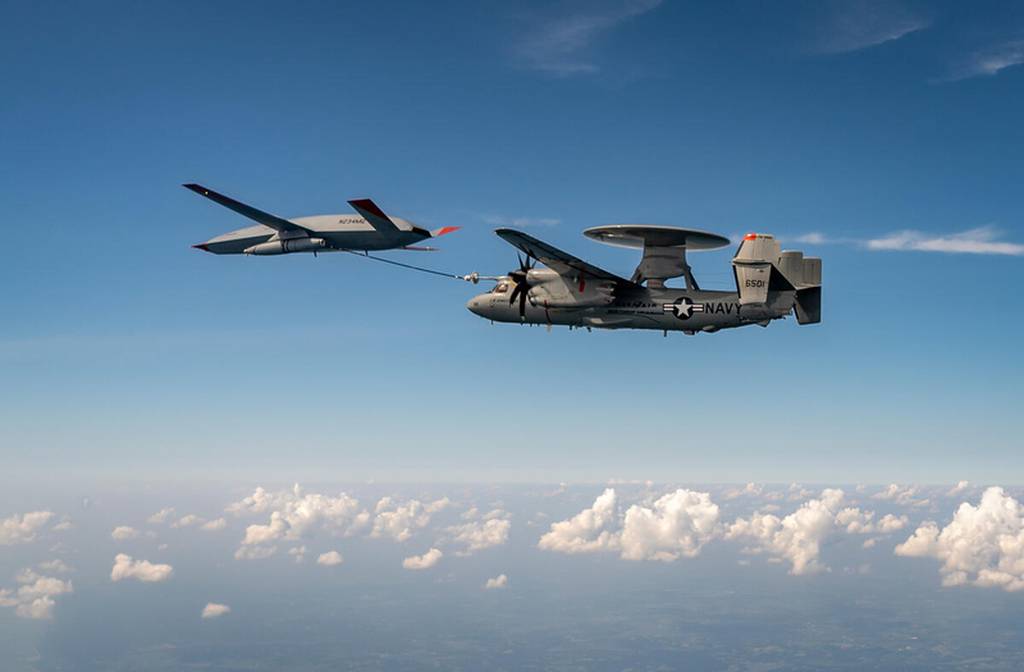WASHINGTON — Boeing said it proved in a virtual demonstration this spring that several U.S. Navy aircraft types could task the company’s MQ-25 Stingray tanker drone with surveillance missions and receive live imagery in support of their own missions.
BD Gaddis, Boeing’s director of MQ-25 advanced design, told Defense News the demonstration in the company’s mobile manned-unmanned teaming laboratory proved that its waveform-agnostic communications architecture worked, that the MQ-25 would be relevant to the surveillance mission and that operators aboard manned planes could easily task the MQ-25 and monitor its findings.
The demonstration took place in May, though Boeing just announced it in a news release this month. More than 100 customers — mostly from Naval Air Systems Command and the chief of naval operations’ staff, with some from the U.S. Air Force — visited for a series of briefs and demonstrations over the course of four days, Gaddis said.
The demonstrations included multiple use cases, or potential operational scenarios: the MQ-25 would fly off an aircraft carrier under the command of a ship-based control station; the air vehicle would announce itself as available for tasking; and one of three Navy aircraft types would take command of the drone from the ground station and send the MQ-25 the parameters of an intelligence, surveillance and reconnaissance mission, including any restrictions or no-fly zones.
Boeing proved its F/A-18 Super Hornet Block III fighter jet and its P-8A Poseidon maritime patrol aircraft, as well as the Northrop Grumman-made E-2D Advanced Hawkeye command-and-control aircraft, could coordinate with the ground control station and the drone during this operation.
Gaddis said the mobile lab included an actual Super Hornet Block III cockpit — one of the key improvements compared to older versions of the jet — that showed visitors how a pilot could grab command of the drone and then see live imagery it captured.
He also said the drone paired well with the P-8, which hunts for submarine and surface ship targets from the air. The demonstration showed the two could operate 300 miles apart, covering a huge swath of ocean as the MQ-25 investigated surface target tracks and passed ones of interest to the P-8 to further investigate or engage.
This spring’s demonstration follows the first-ever MQ-25 manned-unmanned teaming virtual demonstration last year when the MQ-25 was sent on a tanking mission by the ground control station and a Super Hornet or Hawkeye took command of the drone to reroute their rendezvous for a new time and location. Last year, the company also conducted its first-ever live manned-unmanned refueling in the skies over Illinois.
The Navy determined tanking would be the primary mission for MQ-25, with ISR as a secondary mission.
Though the Navy is focused on a formal program of record — with plans to reach initial operational capability as a tanker for the carrier air wing in 2025 — Gaddis said Boeing wants to highlight what else the vehicle can do. The company is already making pitches for the 2025 budget plans, he said, meaning it’s important to demonstrate the maturity of this ISR capability to the Navy and consider future contract actions that will be needed for this manned-unmanned teaming work in the tanking mission, the ISR mission or anything else.
So even while Boeing’s MQ-25 team is focused on the engineering and manufacturing development phase of the program, Gaddis and his group are maturing related future capabilities such as the cybersecurity of the handover from the ground control station to a manned aircraft in the air, developing dynamic mission planning tools, and continuing to mature the communications architecture to ensure total interoperability with the rest of the Navy fleet.
“We’ve got to think past [engineering and manufacturing development], we’ve got to go beyond the program of record because it’s all about the strategic fight in the South China Sea,” Gaddis said.
Megan Eckstein is the naval warfare reporter at Defense News. She has covered military news since 2009, with a focus on U.S. Navy and Marine Corps operations, acquisition programs and budgets. She has reported from four geographic fleets and is happiest when she’s filing stories from a ship. Megan is a University of Maryland alumna.








